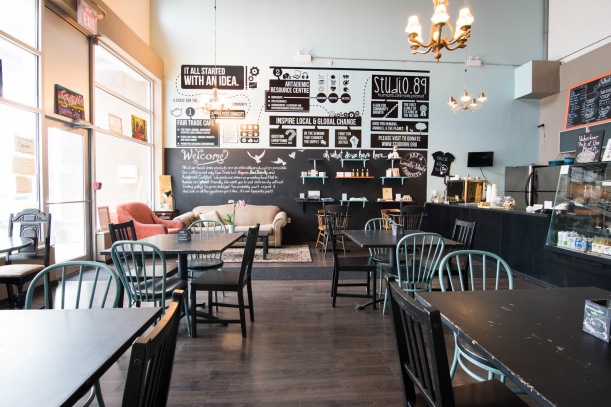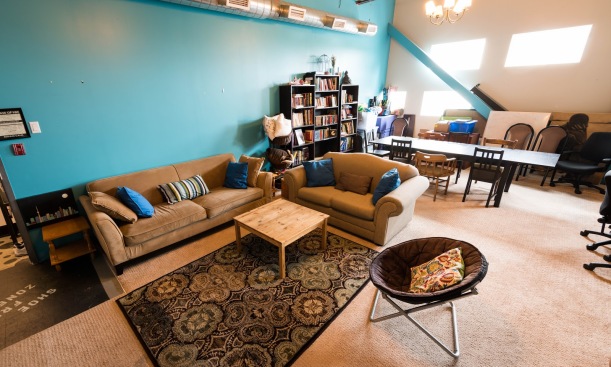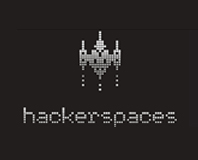Many businesses are parachuted into a community with a one-size-fits-all plan for extracting money. Others emerge from a community organically, both serving and reflecting the people who live there. Studio.89, a fair-trade café in Mississauga, didn’t start out as a business at all — it began as a student-run non-profit called Youth Troopers for Global Awareness. In 2006, a group of students at John Fraser Secondary School came to the conclusion that their community needed greater awareness of local and global issues and their potential solutions. YTGA was created to meet this need. Members of the group quickly identified art as a way of amplifying their voices and sharing their knowledge. As their work expanded, they identified a second, related need — people in Mississauga needed space for events (especially artistic and non-profit events) that was accessible, free and easy to book. Recognizing that Mississauga also lacked places to buy fair-trade coffee and quick, environmentally-conscious meals, YTGA created Studio.89 — a space designed to meet a variety of community needs all at once.
Studio.89 provides free event space to students, artists and community groups and pays the rent by selling fair-trade coffee and affordable vegan and vegetarian meals. I recently interviewed Jazzmine Lawton, the executive director of YTGA, about Studio.89 and the people it brings together.

Inputs and Outputs
In terms of inputs, Studio.89 sells a lot of coffee, but it also makes use of grants and non-monetary inputs like volunteer staff and in-kind donations. Studio.89 receives grants from the Ontario Trillium Foundation and the City of Mississauga. While it has some salaried staff, volunteers serve the coffee and the people running events keep it spick and span. Volunteers come from local high schools, as interns from colleges, and through youth justice programs. They gain experience in the food industry, but also learn about local arts and advocacy groups. Many high school students have stayed on after completing their required volunteer hours because they found the space comfortable and the work meaningful. Drawing volunteers from different places also increases the perspectives in the mix, strengthening Studio.89’s decision-making capacities.
Rent is Studio.89’s biggest expense, followed by admin salaries. Fair-trade coffee is another big expense. Studio.89 could have higher margins if it used cheaper coffee or charged higher prices, but either choice would undermine the space’s mission. Running a business that also has social goals is challenging, but balancing economic and social imperatives gives the café its own eclectic character. Fair-trade coffee at a reasonable price makes Studio.89 stand out from both franchise donut shops and trendy cafés.
Even when sales are buzzing, there are no profits to speak of — potential profits are funneled right back into the organization because a social enterprise’s real output is community well-being. While competition between profit-oriented businesses may gradually find the most profitable use of space, there may be an even more efficient use of space to be found by balancing a variety of needs and goals against one another.
Challenges and Advice
Studio.89 is bustling and vibrant, but it hasn’t always been easy. In fact, the hustle and bustle itself can be a challenge, as admin staff sometimes have trouble focusing on paperwork in such a lively, social atmosphere, even resorting to bringing their work home with them just for peace and quiet. Having two bottom-lines, one monetary and one social, can feel like an unwinnable war. When staff focus on the economics, they risk letting social programming slip, and when they focus on programming there’s a chance that business operations will falter. But at other times, the two aspects work harmoniously — as when an especially popular event helps them sell a ton of coffee and food. Or when a socially-motivated choice like using gender neutral washrooms leads to increased bookings and business from the local LGBTQ community.
For anyone thinking of opening a similar enterprise, Jazzmine suggests building wide-spread community support in advance. Keeping an event space full and paying the rent can be a struggle and it helps to have partnerships and alliances laid out in advance. Jazzmine also suggests taking the business aspect seriously out of the gates and working out a detailed feasibility plan. Working with a non-profit budget and mindset, Studio.89 chose a space that was inaccessible to pedestrians and transit-riders because it was cheap — something they might not have done if they had thought of their initial expenses more like an investment. As a result, Studio.89 doesn’t get many walk-in customers at their present location and has to rely almost entirely on events to draw people in.
Making Space for Free – and Distinctive – Events
Studio89’s event space — in a loft area above the café — is the heart and soul of the enterprise. Last year, they hosted 673 events — about 1/5th were planned by the program coordinator with the rest reflecting the diversity of local interests and ambitions. The artademic centre hosts open mic nights and documentary screenings, but it also provides meeting space for non-profits and small businesses. Unlike many city-run facilities where booking space can be a procedural nightmare, turn around time at Studio.89 is usually within 24 hours. Bookings are done through an online form and reviewed by the program director. Studio89 approves almost all events — though a few events have been cancelled or denied because they made the space unwelcoming to others. Balancing as many community needs as possible, while also holding space for those who are most often excluded, is the programming rule of thumb. Booking the space requires a credit card — but it’s only billed in case of a cancellation or clean-up fee. Charging to cancel a free service weeds out people who don’t take a service seriously just because there’s no price attached without burdening those who really can’t afford to pay.

In our interview, Jazzmine discussed Studio.89’s nuanced response when they noticed that small businesses were dominating their booking calendar. Small businesses are a key component of a thriving community and provide valuable connections for other participants in the space. Studio.89 didn’t want to exclude them, but they also wanted to make sure that those groups they had initially identified as needing better access to event space got their time to shine. The Studio.89 staff made a few changes to their policies: strongly encouraging, but not requiring, donations during regular hours and charging a fee for bookings before the café’s regular hours, a time period that was popular for business meetings. Since then, they have reached a healthier balance between business and non-business bookings. Those businesses that got the most value out of the entire Studio.89 package have stuck around, while those who who were just looking for the cheapest option have moved on. And the early morning bookings are a new source of revenue.
How A Loose Vision leaves Space for the Local Community
Jazzmine explained to me that Studio.89 began with a loose vision of their future. They knew they wanted to sell socially-conscious food and drink and provide a free space where people from Mississauga could connect with one another and speak out about global and local issues — but that conception includes a wide horizon of possibilities. A detailed vision can give a space direction, but it can also cloud one’s gaze, preventing you from looking closely at the texture of your local community. Studio.89’s loose vision has served them well. As they have connected with different resources and needs in an omnivorous way, they have brought together groups and individuals who might never have met under a more tightly planned arrangement. Having found that artists and students are mainly looking for space in the evenings, they are reaching out to seniors’ groups to see if they need free space during the day. Outreach to seniors is a connection that a high-school social justice group might not typically make — but it is one that reflects the reality of the local community. By adapting to the needs and opportunities that surround it, Studio.89 more and more closely mirrors the demographics of Mississauga. The space also helps to draw the community itself together, weaving new connections and knitting new friendships. People getting coffee hear about local poets; entrepreneurs get to know high school students; comedians meet activists and vice versa, creating considerable cross-pollination between groups. Volunteers report that learning about new groups and activities is one of the biggest perks of working at the café. And Jazzmine and her staff are always working to strengthen these connections, pitching in with marketing efforts for causes and shows that need assistance.
As the years have passed, Jazzmine has been amazed by the way that the community has shaped Studio.89. What started out as a loose vision has gradually become a distinct image that draws energy and character from the people of Mississauga. An open-minded outlook lets Studio.89 react honestly and directly to the people around them — rather than focusing on a predetermined model. Having deep roots in the community has also made the space unique. Cookie-cutter chains feel the same everywhere, because their brand is cooked up by a transnational marketing company, rather than being seasoned by the many different people who walk in the door each and every day.

All photos courtesy of Studio.89





